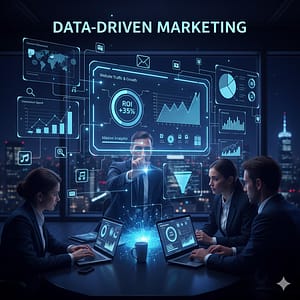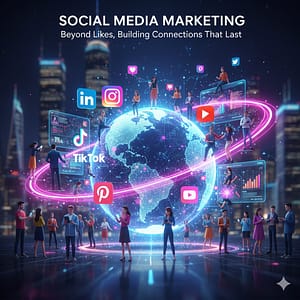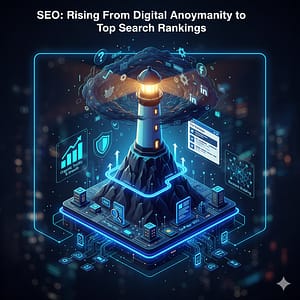The digital marketing world doesn’t just change; it evolves at lightning speed. What worked last year might be obsolete tomorrow. As we look towards 2025, a new wave of technological advancements and consumer expectations is set to redefine how brands connect with their audiences.
Staying ahead isn’t just an advantage—it’s a necessity. To help you navigate this dynamic landscape, we’ve identified the top 7 digital marketing trends for 2025 that will shape strategies, drive engagement, and deliver results. Get ready to future-proof your marketing plan.
1. Generative AI Goes from Assistant to Strategist
Generative AI is no longer a novelty; it’s a core component of high-performing marketing teams. In 2025, its role will evolve from a simple content creation tool to a strategic partner in hyper-personalization and predictive analytics.
- What it is: Beyond writing blog posts or social media captions, Generative AI will be used to create dynamic, personalized ad creatives, email campaigns, and even website experiences in real-time for individual users. It will analyze vast datasets to predict customer behavior and suggest entire campaign strategies.
- Why it matters: Consumers now expect hyper-personalization. Generic messaging gets ignored. AI allows brands to deliver 1-to-1 experiences at scale, significantly boosting conversion rates and customer loyalty.
- How to prepare:
- Invest in AI tools: Explore platforms that integrate generative AI for content, ad optimization, and customer journey mapping.
- Train your team: Focus on prompt engineering and using AI as a creative collaborator, not just a content generator.
- Prioritize data quality: AI is only as good as the data it’s fed. Ensure your customer data is clean, organized, and accessible.
2. The Cookieless Future Demands a First-Party Data Revolution
The end of third-party cookies is here. For years, marketers have relied on them to track users across the web. 2025 is the year where a privacy-first approach, built on a foundation of first-party data, becomes non-negotiable.
- What it is: First-party data is information you collect directly from your audience (e.g., website interactions, purchase history, email sign-ups, survey responses). It’s more accurate, ethically sourced, and powerful than third-party data.
- Why it matters: With regulations like GDPR and the phase-out of cookies by major browsers, relying on third-party data is no longer a sustainable strategy. Brands that master first-party data will build deeper customer relationships and gain a significant competitive edge.
- How to prepare:
- Offer value in exchange for data: Create valuable content, quizzes, loyalty programs, and exclusive offers to encourage users to share their information willingly.
- Implement a Customer Data Platform (CDP): Use a CDP to unify all your first-party data from various touchpoints into a single, comprehensive customer view.
- Be transparent: Clearly communicate your data privacy policy and give users control over their information to build trust.
3. The Unstoppable Rise of Immersive and Shoppable Video
Video content, especially short-form video, continues to dominate social platforms. In 2025, this trend will accelerate with a greater focus on immersive experiences and a seamless path from discovery to purchase.
- What it is: The lines between content and commerce are blurring. Think shoppable TikTok videos, Instagram Reels with product tags, and live stream shopping events. Furthermore, Augmented Reality (AR) filters and simple Virtual Reality (VR) experiences are becoming more accessible for brands.
- Why it matters: Video captures attention like no other format. Making it interactive and shoppable reduces friction in the buyer’s journey, turning passive viewers into active customers instantly.
- How to prepare:
- Prioritize a video-first content strategy: Focus on creating authentic, engaging short-form videos for platforms like TikTok, Instagram Reels, and YouTube Shorts.
- Leverage social commerce features: Tag products directly in your videos and posts, and experiment with live shopping sessions.
- Experiment with AR: Create branded AR filters for Instagram or Snapchat to create fun, shareable user-generated content.
4. Conversational Marketing and AI-Powered CX
Today’s customers expect immediate, 24/7 support. The clunky chatbots of the past are being replaced by sophisticated AI-powered conversational agents that can handle complex queries, understand context, and provide human-like interactions.
- What it is: Conversational marketing uses targeted, real-time conversations to move buyers through the marketing and sales funnels. This includes advanced AI chatbots, live chat, and messaging apps like WhatsApp and Messenger.
- Why it matters: It provides instant gratification and a personalized experience for customers while automating lead qualification and support for your team. A seamless customer experience (CX) is a powerful brand differentiator.
- How to prepare:
- Integrate an advanced AI chatbot: Choose a solution that can integrate with your CRM and provide more than just canned responses.
- Map out conversational flows: Design conversation trees that guide users to the information they need or connect them to a human agent when necessary.
- Be where your customers are: Offer support and engagement through the messaging apps your audience already uses.
5. Purpose-Driven Marketing: Authenticity Over Ads
Modern consumers, particularly Gen Z and Millennials, are increasingly making purchasing decisions based on a brand’s values. In 2025, showcasing your brand’s commitment to sustainability, ethics, and social responsibility will be crucial.
- What it is: This is about genuinely integrating your brand’s purpose into your marketing messages and business operations. It’s not just a one-off campaign; it’s about authentic, long-term commitment.
- Why it matters: Purpose builds trust and creates a strong emotional connection with consumers. Brands that stand for something more than just their bottom line will cultivate a loyal community of advocates.
- How to prepare:
- Define your brand’s purpose: What positive impact do you want to have? Ensure it’s authentic to your company.
- Show, don’t just tell: Back up your claims with tangible actions, certifications, and transparent reporting.
- Involve your community: Use your platform to champion causes and engage your audience in your mission.
6. Voice Search Optimization (VSO) Becomes Mainstream
“Hey Google, find a coffee shop near me.” Voice search is no longer a fringe technology. With the proliferation of smart speakers and voice assistants on every smartphone, optimizing for how people speak—not just how they type—is essential.
- What it is: VSO involves optimizing your content to appear in voice search results. This means focusing on long-tail keywords, natural language, and directly answering user questions.
- Why it matters: Voice searches are often highly specific and have strong local intent, making them a source of high-quality traffic and leads. Ranking for voice queries can position you as the go-to answer in your niche.
- How to prepare:
- Target long-tail, conversational keywords: Think about the full questions your customers would ask.
- Optimize for Featured Snippets: Voice assistants often pull answers directly from Google’s “position zero” boxes. Structure your content with clear Q&A formats.
- Focus on local SEO: Ensure your Google Business Profile is up-to-date, as many voice searches are for “near me” queries.
7. The Re-Emergence of Community and Niche Platforms
While the major social media giants still reign, users are increasingly seeking smaller, more focused communities. In 2025, marketers will find immense value in engaging with audiences on niche platforms like Discord, Telegram, Geneva, or industry-specific forums.
- What it is: Instead of broadcasting a message to millions, this strategy focuses on building deep relationships within dedicated, highly-engaged communities centered around specific interests.
- Why it matters: These communities offer a direct line to your most passionate fans and customers. The engagement is higher, the feedback is more honest, and the potential for building brand advocacy is enormous.
- How to prepare:
- Identify relevant communities: Find out where your target audience hangs out online beyond the big platforms.
- Listen and add value first: Don’t jump in with a hard sell. Become a genuine member of the community by participating in discussions and offering help.
- Consider creating your own community: Launch a branded Discord server or private group to provide exclusive content and build a loyal following.
Conclusion: Adapt or Be Left Behind
The digital marketing landscape of 2025 is less about chasing fleeting tactics and more about building a resilient, customer-centric, and data-informed strategy. The common thread through all these trends is a shift towards more authentic, personalized, and value-driven interactions.
By embracing AI as a partner, prioritizing trust through first-party data, and creating genuinely engaging content, you can not only survive but thrive in the year ahead.
What digital marketing trend are you most excited to implement in 2025? Share your thoughts in the comments below!












Add comment